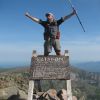Hi, I just wondered if anyone had a more specific report on the very untimely death of a student on a 1971 walk on the Overland Track. I would like to use it as a case study with my Outdoor Pursuits Class.
Cheers
Graeme
1971 Hiking Death
Forum rules
Tasmania specific bushwalking discussion. Please avoid publishing details of access to sensitive areas with no tracks.
Tasmania specific bushwalking discussion. Please avoid publishing details of access to sensitive areas with no tracks.
7 posts
• Page 1 of 1
1971 Hiking Death
"Dare your genius to walk the Wild Uncharted Way" B. Courtney
-

GraemeSpedding - Atherosperma moschatum

- Posts: 66
- Joined: Thu 19 Mar, 2009 2:00 pm
- Location: Perth WA
- Region: Western Australia
- Gender: Male
Re: 1971 Hiking Death
From memory only, they arrived at Waterfall Valley( the old hut no new hut then) and there was no room so decided to move onto Windermere. Got caught in a blizzard. There is a plaque at Windermere.
It was after this incident that Cirque Hut was built. I stayed in the Cirque Hut on my first walk through the Park. Hadnt been official opened at that stage. Thats the only reason I remember anything about it.
Thats all I remember
Roger
It was after this incident that Cirque Hut was built. I stayed in the Cirque Hut on my first walk through the Park. Hadnt been official opened at that stage. Thats the only reason I remember anything about it.
Thats all I remember
Roger
-

norts - Lagarostrobos franklinii

- Posts: 2008
- Joined: Wed 01 Aug, 2007 10:45 am
- Location: Germantown Tas.
- Region: Tasmania
Re: 1971 Hiking Death
I found a couple of references:
http://www.bushwalkingleadership.org.au/Home/about.htm :- "in 1971, Glen Matters, a boy from a Victorian school group, died from hypothermia on a walking trip in Tasmania. At least another ten members of the party were lucky to survive"
Brookes, A. (2003). Outdoor education fatalities in Australia 1960-2002. Part 2. Contributing circumstances: supervision, first aid, and rescue. Australian Journal of Outdoor Education, 7(2), 34-42 :- "In all three Cradle Mountain incidents parties became separated. Individuals who could maintain body heat by activity (i.e. who are not exhausted) and who expected to be able to reach shelter understandably did so, unsupervised. In Cradle Mountain (1971), the party had spread out as conditions deteriorated, but it was the students who successfully reached the hut who assisted with the rescue of those who had not...... In the 1965 and 1971 Cradle Mountain incident there were, in addition to fatalities, successful rescues of additional hypothermia victims by party members and others. Two students walked out to seek assistance in the 1965 incident, which led to the rescue of eight who had sheltered in the boatshed overnight, and four others who had spent a night in the open. Both teachers and five students suffered hypothermia in the 1971 incident; the remaining group members and other walkers brought them to a hut during the night."
which of course had me looking for Part 1: "2 teachers, 19 students. 3rd day of bushwalk, reached hut- full. 4pm continued to next hut. Snow on ground, weather deteriorated. Both teachers and 5 students hypothermic, failed to reach hut by dark. During the night hut occupants worked to get all 7 to hut. 1 student died in the hut."
And there's a part 3: "Three hypothermia incidents involved school bushwalking parties that encountered blizzard conditions. All occurred at the Cradle Mountain end of the Cradle Mountain Lake St Clair National Park (Tas) in the space of six years (1964, 1965 and 1971). The common location is probably not coincidental; risk of hypothermia is a function of both weather and terrain. Each of the incidents had the potential for more deaths. In the 1964 incident a party of 20 including 5 adults became separated in a blizzard. A student, 15, died. In the 1965 incident a student teacher died in an attempt to get a student, who also died, to shelter. In both cases most of the survivors were rescued after the alarm was raised by individuals who walked to safety. In the 1971 incident in which a student died, a teacher also became unconscious from hypothermia but was rescued. In all three cases parties separated as conditions deteriorated (this is not to imply the outcome would have been better had they stayed together – it may have been worse).
http://www.voea.vic.edu.au/riskmanageme ... okes_1.pdf
http://www.voea.vic.edu.au/riskmanageme ... okes_2.pdf
http://www.voea.vic.edu.au/riskmanageme ... okes_3.pdf
Interesting reading and a timely reminder to us all. Also a bit ironic as 1971 was the year that the area or "reserve" became a National Park.
http://www.bushwalkingleadership.org.au/Home/about.htm :- "in 1971, Glen Matters, a boy from a Victorian school group, died from hypothermia on a walking trip in Tasmania. At least another ten members of the party were lucky to survive"
Brookes, A. (2003). Outdoor education fatalities in Australia 1960-2002. Part 2. Contributing circumstances: supervision, first aid, and rescue. Australian Journal of Outdoor Education, 7(2), 34-42 :- "In all three Cradle Mountain incidents parties became separated. Individuals who could maintain body heat by activity (i.e. who are not exhausted) and who expected to be able to reach shelter understandably did so, unsupervised. In Cradle Mountain (1971), the party had spread out as conditions deteriorated, but it was the students who successfully reached the hut who assisted with the rescue of those who had not...... In the 1965 and 1971 Cradle Mountain incident there were, in addition to fatalities, successful rescues of additional hypothermia victims by party members and others. Two students walked out to seek assistance in the 1965 incident, which led to the rescue of eight who had sheltered in the boatshed overnight, and four others who had spent a night in the open. Both teachers and five students suffered hypothermia in the 1971 incident; the remaining group members and other walkers brought them to a hut during the night."
which of course had me looking for Part 1: "2 teachers, 19 students. 3rd day of bushwalk, reached hut- full. 4pm continued to next hut. Snow on ground, weather deteriorated. Both teachers and 5 students hypothermic, failed to reach hut by dark. During the night hut occupants worked to get all 7 to hut. 1 student died in the hut."
And there's a part 3: "Three hypothermia incidents involved school bushwalking parties that encountered blizzard conditions. All occurred at the Cradle Mountain end of the Cradle Mountain Lake St Clair National Park (Tas) in the space of six years (1964, 1965 and 1971). The common location is probably not coincidental; risk of hypothermia is a function of both weather and terrain. Each of the incidents had the potential for more deaths. In the 1964 incident a party of 20 including 5 adults became separated in a blizzard. A student, 15, died. In the 1965 incident a student teacher died in an attempt to get a student, who also died, to shelter. In both cases most of the survivors were rescued after the alarm was raised by individuals who walked to safety. In the 1971 incident in which a student died, a teacher also became unconscious from hypothermia but was rescued. In all three cases parties separated as conditions deteriorated (this is not to imply the outcome would have been better had they stayed together – it may have been worse).
http://www.voea.vic.edu.au/riskmanageme ... okes_1.pdf
http://www.voea.vic.edu.au/riskmanageme ... okes_2.pdf
http://www.voea.vic.edu.au/riskmanageme ... okes_3.pdf
Interesting reading and a timely reminder to us all. Also a bit ironic as 1971 was the year that the area or "reserve" became a National Park.
Carpe diem
-

MJD - Athrotaxis selaginoides

- Posts: 1017
- Joined: Mon 26 May, 2008 11:24 pm
- Region: Tasmania
Re: 1971 Hiking Death
norts wrote:From memory only, they arrived at Waterfall Valley( the old hut no new hut then) and there was no room so decided to move onto Windermere. Got caught in a blizzard. There is a plaque at Windermere.
It was after this incident that Cirque Hut was built. I stayed in the Cirque Hut on my first walk through the Park. Hadnt been official opened at that stage. Thats the only reason I remember anything about it.
Thats all I remember
Roger
I remember this incident well as I did my first trip though the "Reserve" in December 1971, spending Christmas Day climbing Mt Ossa and having lunch in the thick snow from the blizzard the previous week. I can't add much more detail though to norts's memories, but what made it stick in my mind was my recollection of the condition in which we found Windemere Hut where we planned to stay a night, but could not, and so had to walk on to Waterfall Valley. The hut had been trashed internally with all the bunks pulled apart for firewood, and only the shell remaining. We only found out the reason why when we got to Waldheim - the Ranger told us that a school group form Victoria had been caught in a blizzard the week before and only survived by maintaining a fire inside Windermere Hut, but still with one student dying from hypothermia. The local newspapers of the time would have a record of this incident.
"The world reveals itself to those who travel on foot."
Werner Herzog
Werner Herzog
-

tas-man - Athrotaxis selaginoides

- Posts: 1479
- Joined: Mon 03 Sep, 2007 8:55 pm
- Location: Riverside
- Region: Tasmania
- Gender: Male
Re: 1971 Hiking Death
Thanks for this, very useful
"Dare your genius to walk the Wild Uncharted Way" B. Courtney
-

GraemeSpedding - Atherosperma moschatum

- Posts: 66
- Joined: Thu 19 Mar, 2009 2:00 pm
- Location: Perth WA
- Region: Western Australia
- Gender: Male
Re: 1971 Hiking Death
are the risks of hypothermia taught much in any Aussie schools? scouts etc?
in NZ i think most kids would come across a lesson about it at some stage, people die of it every year in NZ, although the education should save a lot more lives
i remember my first winter trip, i'd been educated on hypothermia so i was wearing three layers including on my legs..... wasnt actually that cold but the lessons were burned into my brain....
in another incident I survived it on a vic university snowcraft course way back in the eightes, i recognised i had it which helped me take action to prevent it progressing
in NZ i think most kids would come across a lesson about it at some stage, people die of it every year in NZ, although the education should save a lot more lives
i remember my first winter trip, i'd been educated on hypothermia so i was wearing three layers including on my legs..... wasnt actually that cold but the lessons were burned into my brain....
in another incident I survived it on a vic university snowcraft course way back in the eightes, i recognised i had it which helped me take action to prevent it progressing
from the land of the long white clouds...
-

wayno - Lagarostrobos franklinii

- Posts: 8685
- Joined: Sun 19 Jun, 2011 7:26 am
- Location: NZ
- Region: New Zealand
- Gender: Male
Re: 1971 Hiking Death
I found this report in the Sydney Morning Herald November 26th 1971 on page 3 while doing some research, and post it here to give a bit more detail on this tragic event.
"The world reveals itself to those who travel on foot."
Werner Herzog
Werner Herzog
-

tas-man - Athrotaxis selaginoides

- Posts: 1479
- Joined: Mon 03 Sep, 2007 8:55 pm
- Location: Riverside
- Region: Tasmania
- Gender: Male
7 posts
• Page 1 of 1
Who is online
Users browsing this forum: No registered users and 35 guests
